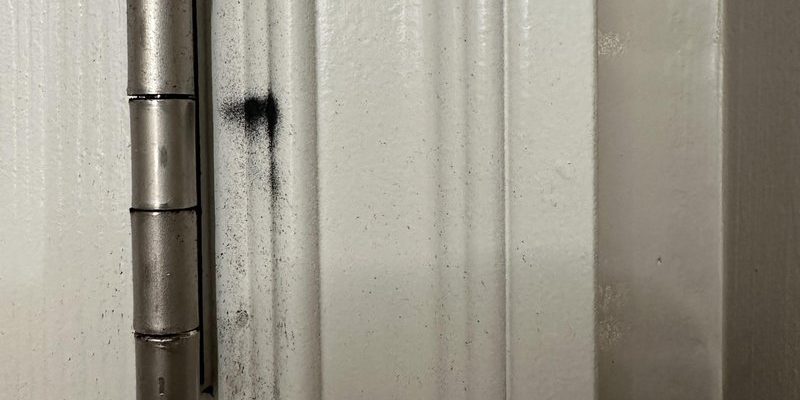
Most of the time, that black residue is just a sign of wear and tear—much like that coffee stain on your favorite shirt. Over time, hinges experience friction, and without proper lubrication, they can start to break down. This breakdown can result in black dust or grime, often made up of graphite from the lubricant you’ve used or even metal shavings from the hinge itself. Understanding why this occurs will not only help you clean it up but also prevent future messes.
What Causes Black Residue on Door Hinges?
The black residue on your door hinges has a couple of common culprits. One of the primary reasons is wear and tear. If your door hinges are older or haven’t been properly maintained, they can begin to degrade. This degradation produces fine particles of metal that can gather and leave a blackish stain on surfaces below.
Graphite lubricant is another likely player in this scenario. If you’ve used a graphite-based lubricant in the past, it can break down over time and create that annoying black residue. Graphite is effective in reducing friction, but when it wears away or gets mixed with dirt, it can show up as a mess. Cleaning it can feel like a chore, but it’s manageable with the right approach.
Different Types of Lubricants
Understanding the different types of lubricants can help you choose wisely in the future:
- Graphite: This lubricant is great for reducing friction, but it can create a messy residue as it disintegrates.
- Oil-based lubricants: These offer smooth operation but can become gummy and attract dirt over time.
- Synthetic lubricants: More costly and longer-lasting, they often do a good job of staying clean.
Choosing the right one can help you avoid messy situations down the road.
Signs Your Hinges Need Attention
If you’re seeing black residue, it’s a good indication that your door hinges need some TLC. But how do you know when they’re truly in distress?
You might notice that your door is squeaking when you open or close it. That’s a huge sign that the hinges lack proper lubrication. Additionally, if the door feels heavy or difficult to move, it’s a telltale sign that the hinges are wearing out.
Sometimes, you might spot a rust-like formation around the hinge, which hints at more severe issues. Rust can lead to hinge failure, so addressing this promptly is essential. Regular maintenance, like cleaning and lubricating, can make all the difference.
What Happens If You Ignore It?
Ignoring these signs might lead to further complications. A misaligned or damaged hinge could force you to replace the entire door or frame down the line, which can be an expensive and time-consuming problem. Plus, if the residue gets on your walls or floors, it can create unsightly marks that are hard to remove.
So, taking action now not only makes sense in terms of maintenance but also helps you avoid more significant repairs later.
How to Clean Black Residue from Door Hinges
Cleaning that black residue is easier than you might think! Start by gathering your supplies. You’ll need:
- A soft cloth or sponge
- White vinegar or a mild cleaning solution
- Lubricant (consider a spray lubricant for easier application)
- A small brush or old toothbrush
Once you have everything, follow these simple steps for effective cleaning:
1. Wipe Down the Hinge: Use the cloth dampened with the cleaning solution to wipe the hinges, removing any loose residue.
2. Brush Away Accumulated Dirt: Gently scrub around the hinge with the brush to get into any crevices, making sure to remove all the black residue you can.
3. Rinse and Dry: If you’ve used vinegar, rinse with clean water and dry thoroughly with a cloth.
4. Reapply Lubrication: Finish the job by applying a new lubricant to ensure smooth operation.
Let’s be honest; a few minutes spent cleaning can save you a lot of headaches later on!
Preventing Future Residue Buildup
Now that you’ve tackled the cleaning, let’s talk prevention. Regular maintenance can help keep your hinges in top shape and free of residue.
You might want to develop a routine check—maybe once a year—where you wipe down hinges, check for wear, and reapply lubricant. Make it a part of your spring cleaning ritual!
Choosing a high-quality lubricant that suits your needs will also minimize future problems. Synthetic lubricants may have a higher upfront cost, but their longevity can save you both time and money in the long run.
When to Replace Your Door Hinges
There will be times when cleaning and lubrication just won’t cut it. If your hinges are rusted, bent, or excessively worn, it might be time for a replacement.
Here’s what to look for:
- If the hinge is loose and won’t tighten, it can compromise your door’s alignment.
- Visible signs of corrosion can deteriorate your door’s integrity.
- If you notice cracks or significant wear, replacement is likely your best bet.
Replacing hinges can be a straightforward task, but measure carefully to ensure a good fit.
Finding black residue on your door hinges can be annoying, but it’s usually a manageable problem. By understanding the causes—like wear and tear or the breakdown of graphite—you can tackle the issue head-on. Regular cleaning, the right lubrication choice, and eyeing for signs of distress can all help in keeping your door functioning smoothly.
Remember, a little attention today means fewer headaches tomorrow. Whether you’re dealing with squeaky doors or unsightly black stains, you’ve got the tools to make it right. Happy maintaining!
